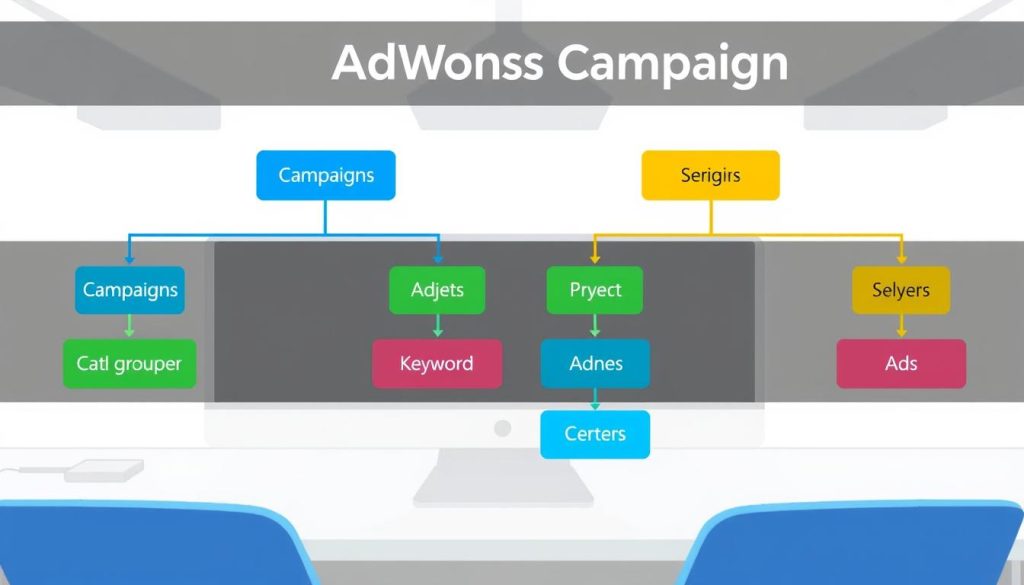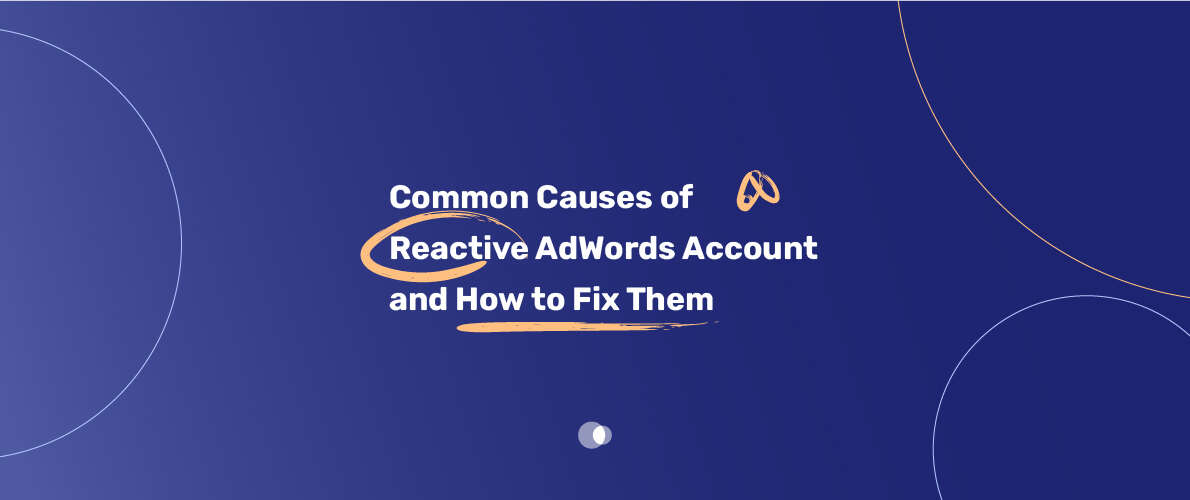In the fast-paced world of digital ads, a successful Google Ads campaign needs a proactive approach. Many marketers find themselves dealing with a reactive AdWords account, constantly trying to fix issues instead of focusing on strategy. Understanding the causes of reactive AdWords account status is crucial for regaining control and ensuring smooth operations.
Table of Contents
A dynamic workspace featuring a laptop displaying the Google Ads interface, highlighting campaign graphs and analytics, is the perfect setting to address Causes of Reactive AdWords Account.

Sticky notes with marketing strategies surround the workspace, reflecting the brainstorming process needed for AdWords account recovery. In the background, a whiteboard brimming with ideas and digital tools emphasizes the proactive approach required to diagnose and resolve issues effectively. The bright office space, complete with plants and natural light, fosters an environment for creative problem-solving.
Key Takeaways
- Understand the impact of reactive AdWords management on key performance indicators.
- Identify the core issues that lead to a reactive approach to Google Ads campaigns.
- Discover strategies for improving budget management and resource allocation.
- Learn how to optimize campaign structure and organization for better performance.
- Implement effective keyword research and management techniques.
- Establish a system for regular performance monitoring and market adaptation.
- Leverage automation and bid strategies to streamline your AdWords account.
Understanding Reactive AdWords Management and Its Impact
In digital advertising, there are two main ways to manage ads: reactive and proactive. Knowing the difference between these is key for the best Google Ads results and a successful AdWords strategy.
Defining Reactive vs. Proactive Management
Reactive AdWords management waits for problems to happen, like running out of budget or poor ad performance. It lacks ongoing checks and focuses on quick fixes. On the other hand, proactive management regularly checks account data, spots issues early, and makes strategic changes to boost long-term success.
The Cost of Reactive Account Management
Reactive AdWords management can cost a lot. Without regular checks and tweaks, ads might not work well. This can lead to wasted money and missed chances for growth.
Key Performance Indicators Affected
- Click-through rate (CTR)
- Conversion rate
- Return on ad spend (ROAS)
A reactive style can lower these important metrics. This makes it harder to reach business goals and hurts the effectiveness of AdWords strategies.
“Proactive AdWords management is the key to unlocking the full potential of your digital advertising campaigns.”
Causes of Reactive AdWords Account: Core Issues to Address
Keeping a proactive eye on Google Ads is key for lasting success. Yet, many businesses end up in a reactive mode, always fixing AdWords troubleshooting problems. They struggle to make their PPC account issues better. Partnering with an experienced AdWords agency can help businesses identify the root causes of these issues and break free from this cycle, paving the way for smoother operations and better results.
One big reason is not planning budgets well or not having enough resources. If budgets run out too soon or don’t change with the seasons, it’s hard to make big changes. This keeps businesses in a constant state of crisis.
Another issue is campaigns that are not well-organized. If ad groups are not connected, keywords don’t match, and landing pages are not good, it’s hard to keep up. Businesses then have to rush to fix these problems.
- Not doing enough keyword research or using negative keywords wrong
- Not checking performance often or keeping up with market changes
- Ad copy and landing pages not matching, wasting money
Fixing these main problems can help businesses move from reacting to acting. They can then focus on making their PPC account issues better. This leads to lasting growth through smart Google Ads optimization.
“Proactive account management is the key to long-term success in Google Ads. Addressing the root causes of reactive behavior is the first step towards a high-performing, optimized campaign strategy.”
Insufficient Budget Management and Resource Allocation
Effective PPC budget optimization is key to managing AdWords accounts well. Yet, many businesses face challenges in managing their AdWords spending. This leads to issues like running out of budget and not using resources wisely.
Budget Depletion Patterns
Budgets often run out too soon, causing campaigns to underperform. This happens when there’s no detailed budget control, ignoring seasonal changes, or uneven resource use. It’s a common problem.
Seasonal Budget Adjustments
Good PPC managers adjust budgets with the seasons. They look at past spending and trends to plan better. This way, they make the most of their Google Ads budget all year.
Resource Distribution Strategy
It’s important to spread resources well across campaigns and ad groups. A smart plan, based on data, ensures top campaigns get the right budget while addressing Reasons Google Ads Not Showing for underperforming ads. Meanwhile, struggling areas get a chance to improve or receive less focus.
By tackling these issues with PPC budget optimization, AdWords spending patterns, and Google Ads resource management, businesses can do better. They can move from reacting to acting, improving their campaigns and getting more from their ads.
Poor Campaign Structure and Organization
Keeping your AdWords account well-organized is key for good PPC management. A messy AdWords campaign structure makes managing your account reactive, not proactive. By following Google Ads best practices for organizing, you can make your PPC account more efficient. This helps you spot and fix problems quickly.
Not having a clear campaign structure is a big problem. Advertisers should group campaigns and ad groups by business goals, product types, or target audiences. This makes it easier to analyze performance, set budgets, and optimize at different levels.
- Organize campaigns by themes or product lines for a clean structure.
- Make ad groups with keywords that fit together well to boost ad quality.
- Use the same naming for campaigns and ad groups to manage them better.
It’s also important to keep your account structure up to date. Advertisers should check their campaign and ad group setup often. They should merge or split them based on how they’re doing and their goals. This keeps your AdWords campaign structure efficient and ready to adapt to changes.

| Best Practices for AdWords Campaign Structure | Benefits |
| Organize campaigns by themes or product lines | Improved performance analysis and budget allocation |
| Create tightly-themed ad groups with relevant keywords | Higher ad relevance and quality score |
| Adopt a consistent naming convention | Easier identification and management of account elements |
| Regularly review and optimize the account structure | Maintain an efficient, agile PPC account organization |
A digital illustration of an organized AdWords campaign structure, featuring a flowchart design with interconnected boxes representing campaigns, ad groups, keywords, and ads. Use vibrant colors to differentiate each element, with arrows showing the relationships between them. The background should be a light, minimalistic workspace environment to enhance clarity and focus on the campaign layout.
“A well-structured and organized AdWords account is the foundation for proactive management and optimal performance.”
Inadequate Keyword Research and Implementation
Effective AdWords management starts with good keyword research and use. Skipping this step can hurt your campaign’s performance. It can also waste your ad budget and miss out on chances. Let’s look at common mistakes and how to avoid them.
Negative Keyword Management
Managing negative keywords is key to avoiding unwanted clicks. It helps you focus on the right audience by excluding irrelevant terms. Keeping your negative keyword list up to date is important for PPC keyword optimization.
Search Term Analysis
It’s important to check the search terms that trigger your ads. This helps you find new keywords, spot negative keywords, and adjust your match types. Keeping an eye on your search term performance can greatly improve your Google Ads search terms and campaign success.
Keyword Match Type Strategy
Choosing the right keyword match types is vital. A good strategy balances broad reach with targeted ads. Using a mix of match types can help you get the right traffic without wasting money. Always be ready to adjust your match type strategy for better results in AdWords keyword research.
By focusing on these areas of PPC keyword optimization and Google Ads search terms, you can make your AdWords account better. This will bring more valuable visitors to your business.
Lack of Regular Performance Monitoring
Keeping a close eye on AdWords performance tracking and PPC analytics is key for a healthy Google Ads account. Sadly, many advertisers don’t monitor their ads regularly. This leads to a reactive management style, hurting your Google Ads reporting and campaign success.
Regularly checking your data helps spot and fix problems early. By setting benchmarks and tracking important metrics, you get insights into your account’s health. This way, you can make smart choices to improve your campaigns and get better returns.
- Regularly review and analyze AdWords performance data to identify trends, opportunities, and areas for improvement.
- Implement custom reporting dashboards to streamline your PPC analytics and stay on top of crucial metrics.
- Set clear performance benchmarks and KPIs to measure the success of your Google Ads reporting and inform your optimization strategies.
Being proactive and always monitoring your AdWords account is crucial. By quickly responding to changes, you can fix issues, seize new opportunities, and keep improving your business results.

A modern office workspace with multiple screens displaying vibrant graphs and charts related to AdWords performance tracking, a person analyzing data with a focused expression, stacks of analytics reports on the desk, a digital clock showing time for regular monitoring, and a large window revealing a city skyline in the background.
“Regular performance monitoring is the backbone of a successful AdWords strategy. It’s the difference between reacting to problems and proactively shaping the success of your campaigns.”
Delayed Response to Market Changes
In the fast-paced world of pay-per-click (PPC) advertising, staying ahead is key. Many AdWords accounts suffer from a reactive management style. This leads to missed chances and poor performance.
A big problem is not responding quickly to market changes. This can hurt your PPC strategy a lot.
Competitor Analysis Frequency
Watching your competitors closely is vital for staying ahead. AdWords competitive intelligence helps you see what they’re doing. This includes their bidding, ad copy, and who they’re targeting.
By keeping an eye on them, you can spot trends. Then, you can tweak your campaigns to stay competitive.
Market Trend Adaptation
Tracking Google Ads trends is crucial for proactive PPC management. It lets you adjust to changes in consumer behavior and market shifts. If you don’t keep up, you might miss out on valuable opportunities.
Seasonal Adjustment Planning
Knowing when demand changes in your industry is important. PPC market analysis helps you plan for these changes. This way, you can make the most of your AdWords budget.
If you ignore seasonal trends, you could waste your budget. This can lead to fewer sales and poor results.
To stay competitive in PPC, you need to manage proactively. Analyze your competitors, track market trends, and plan for seasonal changes. This way, your AdWords account will be ready for success.
Ad Copy and Landing Page Misalignment
In the world of AdWords ad copywriting and PPC landing page optimization, it’s key to keep your ad copy and landing page in sync. If they’re not, it can hurt your Google Ads quality score. This can lead to your account needing constant adjustments and your campaigns not doing well.
Writing ad copy that matches what your landing page offers is crucial. If your ad promises something your page doesn’t deliver, users might leave quickly. This can lower your conversion rates and harm your campaign’s overall performance.
Best Practices for Aligning Ad Copy and Landing Pages
- Make sure your ad copy matches the benefits, offerings, and messaging on your landing page.
- Keep the ad and landing page visually consistent with similar branding and design.
- Optimize your landing page to smoothly follow the story started in your ad.
- Test and refine your ad copy and landing page to fix any misalignment.
- Keep an eye on your Google Ads quality score and work to maintain high scores. This can help your ads perform better and save you money.
By aligning your AdWords ad copywriting and PPC landing page optimization strategies, you can create a seamless user experience. This experience will engage your target audience, boosting your campaign’s success and reducing the need for constant adjustments.
| Key Metric | Aligned Ad Copy and Landing Page | Misaligned Ad Copy and Landing Page |
| Click-Through Rate (CTR) | Higher CTR as users find what they expect | Lower CTR due to user disappointment |
| Bounce Rate | Lower bounce rate as users engage with the page | Higher bounce rate as users quickly leave |
| Conversion Rate | Higher conversion rate as users complete desired actions | Lower conversion rate due to lack of relevance |
| Google Ads Quality Score | Higher quality score due to positive user experience | Lower quality score due to poor user experience |
“Aligning your ad copy and landing page is not just about aesthetics – it’s a fundamental strategy to improve your campaign’s performance and minimize the need for reactive account management.”
Missing Automation and Bid Strategy Implementation
In the fast-paced world of PPC advertising, keeping up is key. Many AdWords campaigns lack automation and advanced bid strategies. This makes management reactive and performance suboptimal. Fixing this can greatly improve campaign efficiency and returns.
Smart Bidding Options
Google Ads smart bidding uses machine learning to tweak bids for better performance. Options like Target CPA, Target ROAS, Maximize Conversions, and Maximize Clicks help manage PPC bid strategies more effectively.
Rule-Based Automation
Rule-based AdWords automation lets you automate tasks like budget pacing and bid adjustments. By setting specific rules, your campaigns can quickly adjust to changes. This saves time and resources.
Scripts and Tools Integration
Using Google Ads scripts and third-party tools boosts your AdWords automation strategy. They help with automated reporting and performance optimization. These tools can take your PPC management to new levels.
Smart bidding, rule-based automation, and strategic script integration can change your AdWords account. It can go from reactive to proactive and high-performing. Unlock your PPC campaigns’ full potential and drive business growth.
Conclusion
In this article, we’ve looked at why AdWords accounts often react instead of proactively manage. We’ve talked about how to fix issues like bad budgeting, poor campaign setup, and not checking performance often. Advertisers can make their Google Ads better and get more success by doing these things.
It’s clear that making AdWords work well needs a good grasp of budgeting, keyword research, and ad and landing page matching. Using automation and smart bidding is also key. Keeping an eye on things and being ready to change with the market is vital for beating competitors and getting the most from your ads.
By using AdWords optimization tips, PPC management best practices, and Google Ads success strategies, you can turn a reactive account into a top-performing one. This will help your business grow in the fast-changing world of digital ads. Always keep learning and adapting to stay ahead.
FAQ
What is the difference between reactive and proactive AdWords management?
Reactive management waits for problems to happen. Proactive management keeps an eye on things and makes changes to avoid issues. It aims to keep campaigns running smoothly .
How does reactive AdWords management impact key performance indicators?
Reactive management can hurt click-through rates, conversion rates, and return on ad spend. This is because problems are not fixed and chances are missed. Proactive management keeps campaigns performing well.
What are the primary causes of reactive AdWords account management?
Issues like not managing budget well, poor campaign setup, and not doing keyword research are common. Not watching performance closely, not adapting to market changes, and ad-landing page mismatch also cause problems. Not using automation or bid strategies is another issue.
How can advertisers address budget depletion and resource allocation issues?
To fix budget problems, look at how budget is used, adjust for seasons, and plan resources wisely. This helps manage campaigns and ad groups better.
Why is a well-structured AdWords account important for proactive management?
A well-organized account makes it easier to see how things are doing. It helps spot problems and make focused improvements.
What role does keyword research and implementation play in reactive management?
Good keyword research and management are key. They help target better, save money, and keep the account in control.
How can regular performance monitoring help prevent reactive management?
Regular reports and data analysis help spot and fix issues early. This way, problems don’t get worse.
Why is it important to stay responsive to market changes in AdWords?
Keeping up with competitors and market trends is crucial. It helps stay competitive and keep campaigns effective.
How can ad copy and landing page alignment impact AdWords performance?
Matching ad copy and landing pages improves quality scores and conversion rates. It also makes for a better user experience, leading to better campaign results.
What role do automation and bid strategies play in proactive AdWords management?
Using smart bidding and automation helps manage accounts better. It makes things more efficient and frees up time for important decisions.



